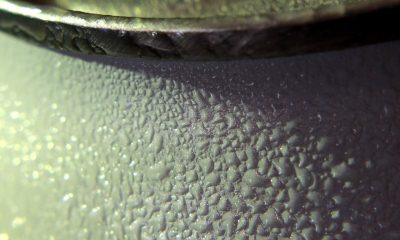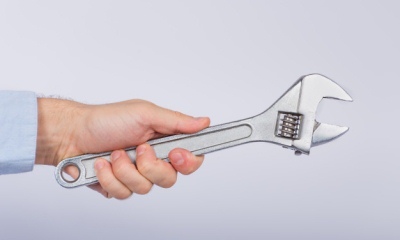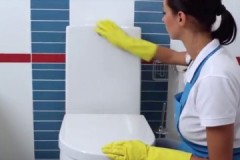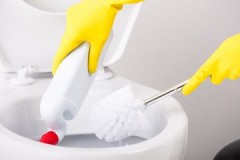Professional plumbing tips on how to remove condensation from your toilet cistern
 Condensation on the toilet cistern is not uncommon. Drops of water, and sometimes drips, not only look bad, but can also lead to unpleasant consequences - from damage to metal fasteners in the room to the development of mold.
Condensation on the toilet cistern is not uncommon. Drops of water, and sometimes drips, not only look bad, but can also lead to unpleasant consequences - from damage to metal fasteners in the room to the development of mold.
This problem requires a solution using simple techniques. We will tell you how to remove condensate from the toilet cistern in an apartment and a private house in the article.
Content
Moisture droplet formation factors
Condensation forms on surfaces that are exposed to temperature changes. With a flush cistern in the toilet, the situation is exactly this: rather cold water flows into it, and the air in the room itself is warm. The walls cool quickly, which leads to the appearance of moisture on the outside.
 Factors contributing to a large temperature difference are:
Factors contributing to a large temperature difference are:
- high humidity in the toilet:
- violations in the ventilation system;
- the proximity of pipes with hot and cold water;
- breakdowns in the device of the tank itself - a leak, which leads to a constant supply of cold water.
The minimum temperature difference that can lead to condensation is 15 degrees.
Ways to fix the problem in an apartment and a private house
To solve the problem with condensation, it is necessary to inspect the room and the tank itself. If the fogging of the tank during the cold season and the appearance of condensation is not permanent, then additional measures may not be taken. In this case, the surface of the tank has time to dry before the next visit to the toilet, and does not pose a threat.
Ventilation normalization
If the cause of condensation is poor ventilation, then the way out is:
- More frequent ventilation.
- Organization of natural air exchange by installing special valves in the door itself leading to the toilet or buying a door with a gap of 10-15 mm along the lower edge.
- Cleaning the ventilation shaft.
- Air dryer installation.
- Installation of an exhaust system into an outlet.
They will help in improving the microclimate and following simple rules:
- after wet cleaning, allow the room to dry well without closing the door;
- if the bathroom is combined, then do not cover the entire space with things wet after washing, reduce the time for taking water procedures, especially with the formation of steam;
- finish washing surfaces by wiping the walls dry.
Water pipe thermal insulation
The water flowing through the pipes has a low temperature in winter. This can be done by insulating the supply pipes and insulating the riser with cold water into the box.
If the reason is breakdown
 The most common reason for the appearance of moisture outside the tank is leaks.leading to the fact that water gradually leaves, and its missing volume is supplemented from the pipeline.
The most common reason for the appearance of moisture outside the tank is leaks.leading to the fact that water gradually leaves, and its missing volume is supplemented from the pipeline.
In this case, the liquid does not have time to warm up, and there is always cold water in the tank.
The solution to the problem is to repair the mechanism and replace the gaskets... If the water does not spontaneously flow out, then the moisture on the tank itself will either not form at all, or it will become much less.
Insulation of the toilet itself
Insulating the toilet room also helps to reduce the amount of condensation. You can insulate the ceiling, walls and floor. Only those materials that are suitable for rooms with high humidity should be used for these purposes.
Tank modernization
Other methods of dealing with moisture on the surface of faience associated with the refinement of the device itself:
- Insulation of the tank itself from the inside.
- Installation of a new double-layer cistern made of plastic and faience.
- Modernization of an existing cistern by placing another plastic container inside it. It should fit freely inside the earthenware bowl and leave a gap between the containers of at least 2 mm. The role of the seal is played by silicone or rubber gaskets.
- Organization of pre-heating of water entering the tank.
Most of the work related to the modernization of the tank requires special knowledge and experience.
If polyurethane foam has been used as insulation on the inside of the tank, it can only be trimmed and leveled after it has completely dried. It is convenient to use a clerical knife for these purposes. Despite the functionality, such insulation does not look presentable and is inferior to other means.
Another option is to use a mixture of sealant and glass microspheres.used for car tuning. The prepared product is applied in a non-thick layer about 3 mm thick. Drying time depends on the specific sealant, this information can be found on the packaging.
How to remove condensation on the toilet cistern, the video will tell you:
Minimum drain function
Many cisterns have two drain buttons... One of them allows you to pour out not all the water from the tank, but only part of it. At the same time, new cold water begins to flow into the container, but there will be less of it than when the tank is completely empty.
The two-stage flush button will also help save water consumption, especially if you use the toilet frequently.
Warm water supply to the tank
Another non-standard solution to the problem is to supply the tank with not cold, but warm water. This option can be organized in several ways - for example, by hinge shifting. The disadvantage of this solution is the increased cost of water consumption for flushing the toilet.
12 important recommendations
Professional advice will help you solve the problem in an optimal way:
 The source of moisture and condensation can pose a threat to metal fasteners, lead to deterioration of the finish, the appearance of mold and other unpleasant consequences, therefore, requires timely elimination.
The source of moisture and condensation can pose a threat to metal fasteners, lead to deterioration of the finish, the appearance of mold and other unpleasant consequences, therefore, requires timely elimination.- Abundant condensation is a cause for immediate action, as water drips and can form puddles on the floor and even lead to flooding of neighbors.
- When organizing the internal insulation of the tank, it should be borne in mind that the layer of insulation should not be very thick, as this can lead to a decrease in the volume of the contained water. Optimally - up to 1 cm.
- The leakage of water unjustifiably increases its consumption, therefore, it requires elimination in a short time, even if at first glance the leak is not large, and the water leaves in a thin stream.
- The design of the elements of the drainage system must be able to move freely and not touch the walls of the tank after it has been insulated.
- Decreasing the temperature in the toilet room also leads to a decrease in condensation, but the comfort of being in the room will also be reduced, so this method should not be used.
- The installation of the toilet cistern must be carried out efficiently, in compliance with all requirements, and clearly according to the instructions.
- Qualitatively fixed thermal insulation inside the tank can serve for many years without losing its properties, therefore it must be glued carefully and kept until completely dry before starting operation.
- If possible, it is advisable to place a riser with cold water in a box.
- It is recommended to lay pipes with hot water in the toilet away from the tank, as well as to place a heated towel rail or heating radiators at a distance.
- For ease of use, ventilation and ventilation means can be connected to the toilet light switch and start automatically.
- The ventilation opening should not be blocked, even if it violates the overall aesthetics of the room.
Conclusion
There are several ways to remove condensate from the tank. The best option is an integrated approach that combines monitoring the health of equipment with good ventilation and maintaining hygiene.



